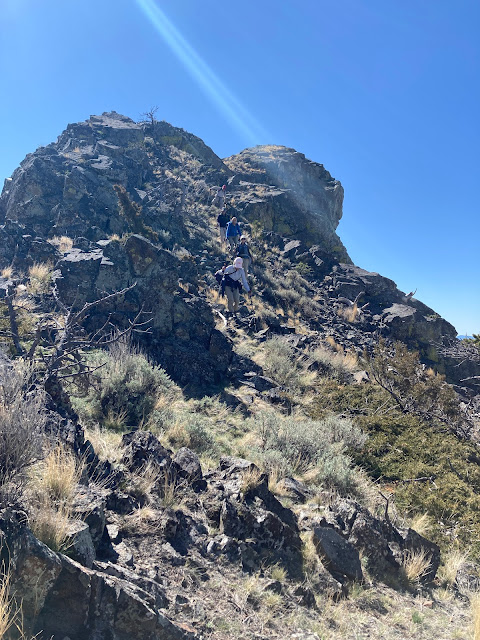 |
| Lunch break on top of Gold Butte in the Sweetgrass Hills looking out toward West Butte |
 |
| Descending to the dry plains from Gold Butte |
 |
| Gold Butte in the Sweetgrass Hills |
 |
| Katie and Laurie Lintner on Two Medicine Ridge lookout site |
 |
| Wilbur Falls at Many Glacier |
 |
| Pink Douglasia alpine flowers at Rogers Pass |
 |
| Blue and yellow alpine flowers mimic the Ukrainian flag |
The alpine flowers have sprung into full flower, and despite the ultra-dry weather, the prairie is in bloom as well.
I always look forward to the time of year that the Forget-Me-Nots bloom, and now for the next couple of weeks you'll find these fragrant, colorful blue dots on alpine ridgelines.
This past week the trees in town finally started to leaf-out so we headed out to the Belt Creek valley and found a sea of greenery.
It was such a treat and relief from a long winter and a cold, dreary spring.
On Monday I headed up to Rogers Pass on the Continental Divide and walked up Rodgers Peak on the east side of the pass and to the ridgeline on the west side, covering about 2,200 feet of elevation gain and loss on the Continental Divide Trail.
On the Rodgers Peak side there were about three inches of soft snow for the final 500 feet to the top. On the west side, it was clear. The pink Douglasia was blooming in profusion with the Forget-Me-Nots just starting. I would think the next 10 days would be the time to see these blue beauties. The cool spring is holding the snow in the high country here on east and north facing slopes.
The prairie is another matter.
It is bone dry, and that spells real trouble in our area that is in extreme drought anyway.
We found the prairie heading to Gold Butte in the Sweetgrass Hills on the Canadian border, a gray-brown mass of dry. There were some flowers, but this country should be green by now. About the only green we saw were fields where the winter wheat is going.
We had hoped to climb the butte --- really a steep mountain of igneous talus ---- from Cameron Lake on its west side, along the route we had done 17 years ago.
The problem was that the road was so rutted that the car's bottom scraped and we had to park nearly a mile from our planned departure spot. We figured it added about 2 miles to our trip across long, brown fields and required us to crawl under four fences and go through a gate.
Our normal route up this mountain is from the town of Gold Butte, and we had along with us Gordon Whirry, whose great grand parents homesteaded the area. He knows the ranch families in the area and history of this country.
I was pretty slow going up and coming down the extensive, large talus on the final 600 feet up to the top of the peak, and my thighs were really sore the next day.
Despite that soreness, we went to Glacier on Thursday and visited Two Medicine and Many Glacier .
Friend Laurie Lintner, who grew up in East Glacier Park, accompanied us and treated us to a hike to the site of the former fire lookout on top Two Medicine Ridge just above the pass at Looking Glass Highway.
We were treated to phenomenal views into Glacier and then a walk across the ridge.
I came away with ideas for cross country skiing here, and then saw a nice alpine lake at the base of Spot Mountain to the northwest. Laurie pointed out that above the lake is the Boundary Trail that goes across that base and into the Cut Bank Creek area. I need to go.
There were other hikes during this period including River's Edge Trail from Giant Springs to Crooked Falls Overlook, where we found many prairie flowers including golden pea and penstamin. Wa also went the Belt Creek Ranger Station in the Little Belts to look for the Fairy Slipper wildflower and found several on Crawford Creek and Pioneer Ridge trails nearby. However, we're early for those.
And, then one more trip to Rogers Pass to check the progress of the wildflowers and found that the Forget-Me-Nots were now in full bloom.













